woodlands web updates : 25
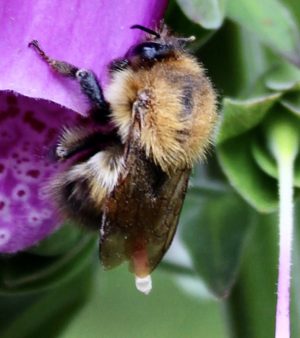
Earlier flowering times.
A survey has shown that plants are flowering earlier in the year. Cambridge University researchers compared the dates of flowering of some four hundred plus species before and after 1986. They found that plants are now flowering roughly one month earlier. More recent decades have been associated with rising air temperatures.
This change in flowering time may have profound consequences for the plants. The vast majority of plants are dependent on pollinating insects (bees, bumblebees, hoverflies) to set seed and complete their life cycles. By flowering early their cycle, plants may not match up with the activities of their pollinators. They may flower but their pollinators bee ‘missing’. Their pollinators need to emerge from their overwintering stage earlier.
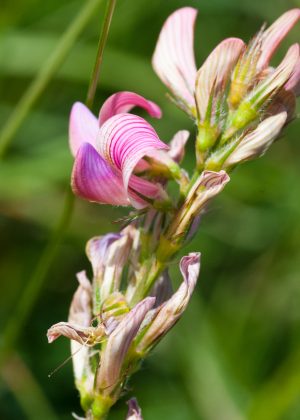 Earlier flowering may not matter for those plants that are visited by several pollinators but for those that are dependent on one or two specific visitors - it may critical. For example, Sainfoin. Sainfoin is host to a particular (solitary) bee Melitta dimidiata (remote image here). It is a monolectic bee; i.e., a bee that collects food (nectar and pollen) from only one species of flower - the sainfoin. If the sainfoin flowers earlier in the year and the bee does not match the shift in flowering, then the bee has a problem.
Earlier flowering may not matter for those plants that are visited by several pollinators but for those that are dependent on one or two specific visitors - it may critical. For example, Sainfoin. Sainfoin is host to a particular (solitary) bee Melitta dimidiata (remote image here). It is a monolectic bee; i.e., a bee that collects food (nectar and pollen) from only one species of flower - the sainfoin. If the sainfoin flowers earlier in the year and the bee does not match the shift in flowering, then the bee has a problem.
Work on the effects of climate change on pollinators has been somewhat limited to date, but studies in Japan suggest that bees / bumblebees are somewhat behind plants in their response to environmental changes.
Bee and bumblebee news.
Recent research data provide evidence that (buff tailed) bumblebees are not able to detect or avoid concentrations of pesticides [imidacloprid, thiamethoxam, clothianidin, or sulfoxaflor], as used ‘on the farm’ - from signals sent by their mouthparts. The mouthparts are covered with tiny hairs and these hairs have ‘pores’ in them. Chemicals pass through these ‘pores’ to sensory cells; this is how the bee tastes and smells. It seems likely that the bumblebees are at considerable risk of consuming pesticides in their search for nectar when visiting pesticide-treated crops.
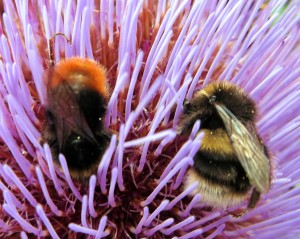
Bumbles foraging in artichoke
Another agrochemical, Roundup, has been found to affect the learning and memory of bumblebees. Roundup, which contains glyphosate, affects their ability to learn and memorise connections between colour and taste. Impaired colour vision is likely to affect the foraging and nesting success of the bees. The research was conducted in Finland by researchers at the University of Turku.
In yet another concerning study, researchers at the University of Maryland have found that the life span of laboratory-raised honey bees has reduced considerably. Five decades ago, the lifespan for a worker honeybee (Apis mellifera) under controlled laboratory conditions was about 34 days. Now it is some 17/ 18 days - according the report in Nature. The study also reviewed the scientific literature [from the 1970s to now] and noted a trend in the life span of bees. Shortened worker bee lifespan has implications for colony health and survivorship. The work at the University of Maryland is ongoing.
Methane release.
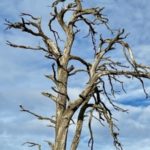 Ghost forests are found in coastal areas. As a consequence of climate change, sea water has ‘invaded’ low laying areas and trees have died. The dead trees are sometimes referred to as ‘snags. A number of woodland / forest communities along the eastern coast of the United States have been affected.
Ghost forests are found in coastal areas. As a consequence of climate change, sea water has ‘invaded’ low laying areas and trees have died. The dead trees are sometimes referred to as ‘snags. A number of woodland / forest communities along the eastern coast of the United States have been affected.
Recent work by North Carolina State University has shown that these ghost forests release methane. The methane is generated by bacteria in the soil but then ‘escapes’ by means of the ‘snags’. As it passes through the wood of the ‘snags’, microbes may consume and alter the methane. As methane is a potent greenhouse gas, understanding the nature and extent of these methane emissions from ‘ghost forests’ is important.
Tree rings
The study of tree rings has been invaluable in dating many historic objects ./ archaeological sites. Now, it 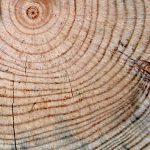 seems that they could play a role in estimating the amount of carbon that trees are actually absorbing (carbon sequestration), if woodland / forest inventories are coupled with core samples of the trees. The measurement of the annual rings from such cores could create a record of ‘tree growth across space and time’, yielding a more accurate estimate of the amount of carbon being taken up by woodland and forests. Forests, soils and oceans are major ‘carbon sinks’.
seems that they could play a role in estimating the amount of carbon that trees are actually absorbing (carbon sequestration), if woodland / forest inventories are coupled with core samples of the trees. The measurement of the annual rings from such cores could create a record of ‘tree growth across space and time’, yielding a more accurate estimate of the amount of carbon being taken up by woodland and forests. Forests, soils and oceans are major ‘carbon sinks’.
Comments are closed for this post.
